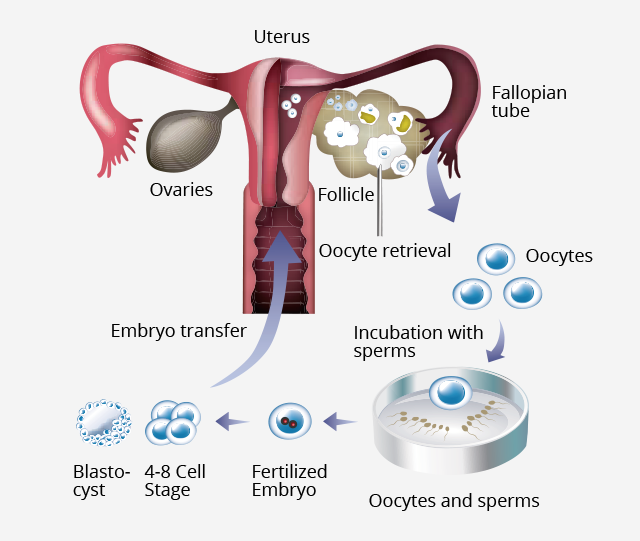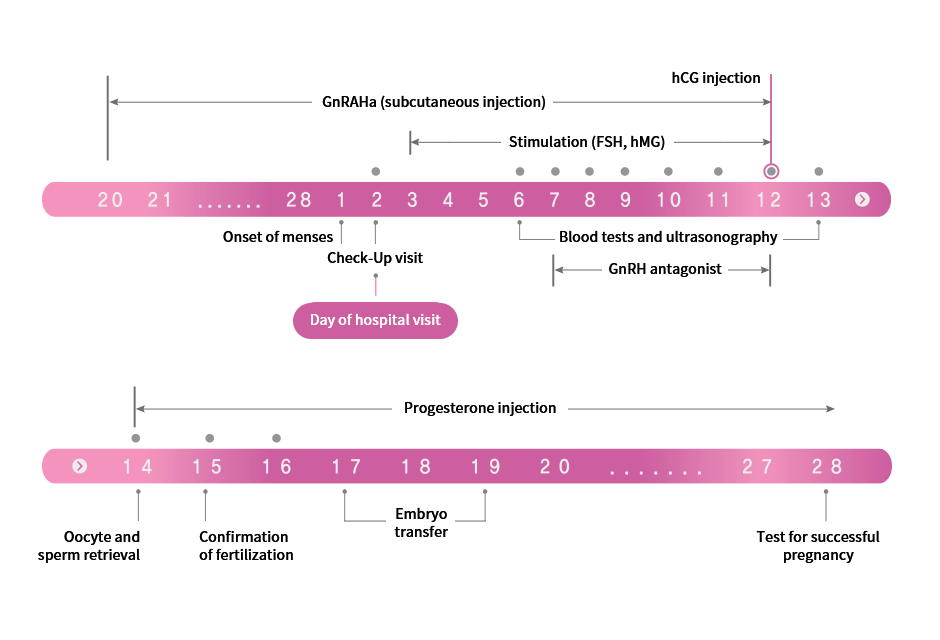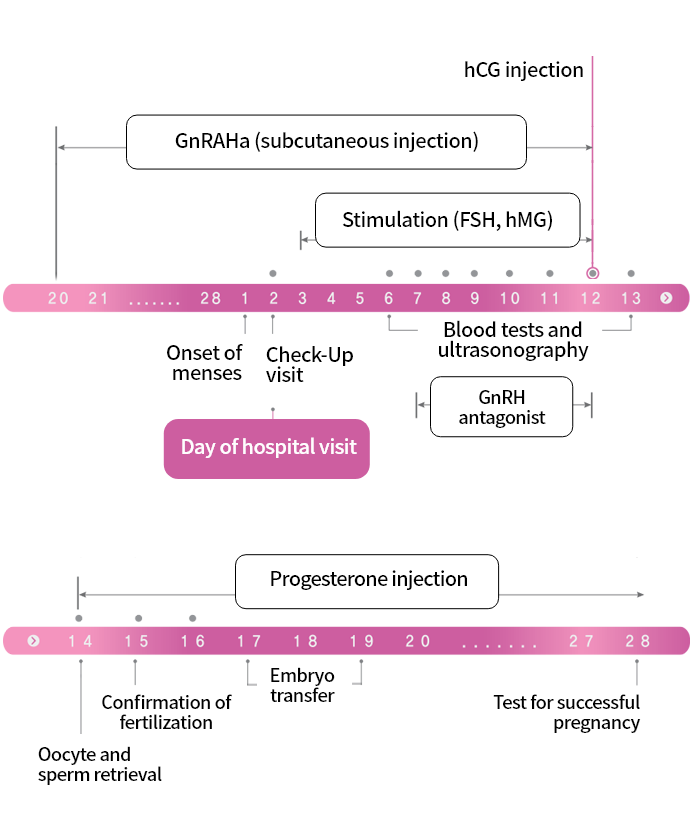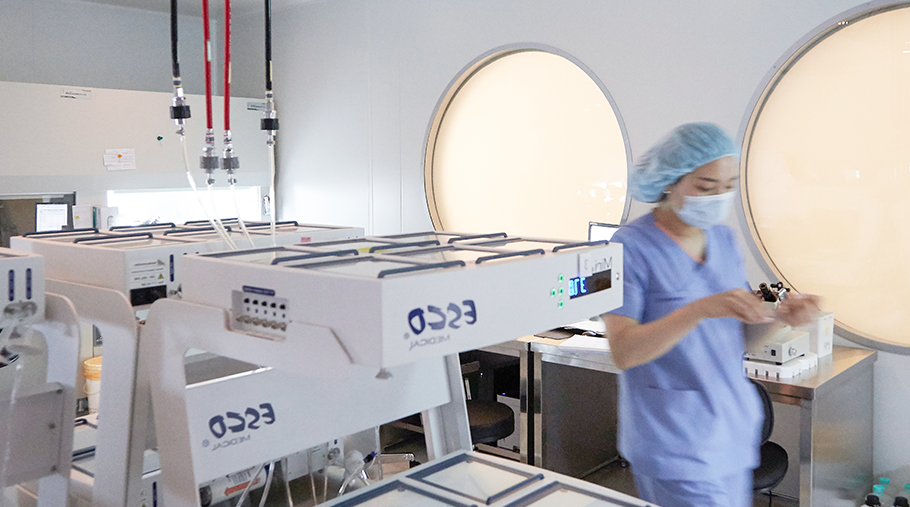-
In Vitro Fertilization
In-Vitro Fertilization
IVF is a procedure in which a woman’s mature oocytes and a man’s sperm are collected to be fertilized outside of the body, and the resulting embryo is implanted in the uterus after 2~5 days of external incubation.
Target
IVF is the method of choice in the cases of blocked or surgically lost fallopian tubes blocked or surgically lost, previous failure of salpingoplasty, immune fertility (where the woman’s own immune system rejects sperm), male fertility, endometriosis, repeated failures of artificial insemination, necessity of preimplantation genetic diagnosis, otherwise unknown causes.


Procedure
IVF is the method of choice in the cases of blocked or surgically lost fallopian tubes blocked or surgically lost, previous failure of salpingoplasty, immune fertility (where the woman’s own immune system rejects sperm), male fertility, endometriosis, repeated failures of artificial insemination, necessity of preimplantation genetic diagnosis, otherwise unknown causes.
-
01
Controlled ovarian hyperstimulation
- Natural ovulation stimulation
- Artificial ovulation stimulation
-
02
Oocyte and sperm retrieval
-
03
In vitro fertilization and embryo culture
- In vitro fertilization (IVF)
- Intracytoplasmic sperm injection (ICSI)
- Intracytoplasmic morphologically selected sperm injection(IMSI)
-
04
Embryo transfer
- Procedure conducted under sedation without anesthetic
- Embryo inserted in uterus through thin tube through the cervical canal
-
05
Confirmation and maintenance of pregnancy
Embryo implantation


-
01
-
State of the Art Fertility Center
Embryoscope System
This is an unmanned system that monitors individual embryos in the development stage. It is safe for the embryo as images of the embryo are taken without external exposure, and a multi-focusing, cross-sectional time-lapse microscope is used for accurate observation of the pronuclei and blastocyst stage to screen for excellent embryos.
Laser Assisted Hatching
In order to implant into the uterine lining, an embryo has to hatch out of the zona pellucida surrounding the embryo. zona pellucida blastocyst and this process is referred to as “embryonic hatching.” If the zona pellucia is abnormally thick, making it difficult for the embryo to hatch out itself, assisted hatching is performed to facilitate implantation.
 Assisted hatching
Assisted hatchingUltra-precision laser equipment is used to emit laser on the zona pellucida for a short period of time to create a small hole (zona drilling) or to make the zona pellucida thinner (cruciate thinning of zona pellucida). In comparison to the conventional assisted hatching technique involving the use of an acidic solution, it is less harmful and time-consuming. It is the latest technology that increases the success rate of implantation and pregnancy.
Recommended forPatients who failed to conceive even after the transfer of an embryo that underwent normal development following an in vitro fertilization
Cases in which failure of implantation or pregnancy is expected due to problems in the zona pellucida.Cryopreservation Method
Cells (eggs, sperms, fertilized eggs) are stored at an ultra-low temperature (-196℃) to temporarily stop all biological activity, and thawed when necessary for use.
Embryo FreezingFertilized eggs remaining after the embryo transfer procedure are stored so that they can be used in the following ovulation period in case the patient fails to get pregnant.
Vitrified FreezingDamage or injuries to the fertilized egg can be minimized as the formation of ice crystals is prevented.
Embryo Freezing Is Recommended in the Following Cases
- There are fertilized eggs remaining after the Embryo Transfer to the uterus after an in-vitro Fertilization procedure
- The patient is at diverse risks associated with ovarian hyper stimulation syndrome (OHSS) caused by excessive ovulation induction
- The endometrium is unsuitable for the Embryo Transfer
- Failure of Embryo Transfer was caused by an anatomical reason such as stenosis of the uterine cervix
- The patient is in poor health condition such as having a fever or overall body-ache etc
- It is difficult to schedule a transfer period that is ideal for the egg donor and recipient
- Higher success rate of pregnancy is expected from the transfer of a fertilized egg that is thawed in a natural or hormonal cycle, rather than from a transfer after ovulation induction